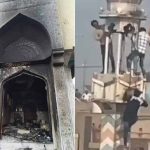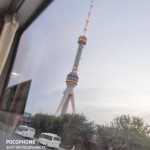As observed by Jiten Nandi, Shamik Sarkar, Md. Helaluddin, Subhapratim Roychowdhury, Anupam Das Adhikari and Amita Nandi on behalf of Manthan Samayiki, a bi-monthly Bengali little magazine from Kolkata, West Bengal
We, associated with a Bengali bi-monthly little magazine, ‘Manthan Samayiki’, went Nandigram three times during January to March. Being the residents of Metiabruj in Kolkata, we are neighbored by the people involved in garment industry, a community-based industry of muslim bengalees.
Thousands of male villagers (about seventy – five thousand, according to Morsalin Molla, MLA, Mahestala, South 24 Parganas) from Nandigram block stay in Metiabruz and around temporarily for working in the community garment industry. We went Nandigram each time along with these people. We visited there on 18th January, 17-18 March and 27-29 March 2007. We travelled within Nandigram by bicycles and vanrickshaw. Nandigram is almost 160 km away from Kolkata. There are three blocks, Nandigram I, II, and III in the district of East Medinipore. Nandigram I block is mostly dominated by muslims and lower caste hindus. People survive by cultivation, fishing, and engaging themselves in garment industry. Haldia township and industrial belt, being just opposite to the Haldi river, promised them a huge opportunity of getting employment in modern industries. But in reality, most of the workers who got jobs there, were driven off once the construction works were finished. They realized that, in modern industries only highly educated elites could manage a respectful job. Village people are going to get nothing from there. Still now, some villagers go Haldia, for purely temporary contractual jobs with miserably low salary. We heard about the Jellingham Project at Nandigram Block 1, where about 400 acres of land had been acquired in 1977 for ship repairs. One hundred and forty two families lost their land. The Project stopped functioning after five years and the site today lies deserted. Nandigram fought British colonial rule gloriously, almost occupied itself from British Raj in 1942. It took part in the tebhaga movement afterwards, under the leadership of legendary Communist Bhupal Panda. The indomitable spirit of the community (the chashi-samaj) Nandigram was carried positively by the leadership of Communist Party of India in tebhaga movement. Time and again, Nandigram village-folks dug trenches on roads to fight the aliens.
In 1982, a movement under the leadership of Bhupal Panda originated in Nandigram with the demand for development (roads, sanitation, water supply, electrification, etc.). Police fired on the agitation and killed a student, Sudipta Tewari. Again, village-folks dug trenches in Nandigram to prevent police from entering into the villages. A rumour was there in Nandigram for more than a year that some of the mouzas or villages and cultivation land might be acquired by the State Government for instituting an industrial zone, Special Economic Zone (SEZ). A land acquisition row was already there nearby for increasing the area of Kulpi port which would take lands from coastal area belonging to mostly fisherfolks and farmers. A committee, dubbed as Krishak Uchchhed Birodhi 0 Jonoswartho Roksha Committee (Committee Against Eviction Of Peasants And To Save People’s Interest) was formed during August 2006 by Socialist Unity Centre of India (SUCI) along with Indian National Congress for propaganda work against forced land acquisition.
Another committee started to function in Nandigram and adjacent Khejuri block, called Krisi Jami Raksha Committee (KJRC) (Committee To Save Farmland). It is a state-wide initiative led by main parliamentary opposition party, called Trinamul Congress, formed in the pretext of land acquisition row in Singur of district Hooghly for a Tata Motor’s manufacturing unit.
Another initiative, called Gana Unnoyon O Jana Odhikar Sangram Samity (GUJOSS) (Association For The Struggle Of Mass Development And People’s Right), comprised of Jamait I Ulema Hind and Communist Party of India (Marxist-Leninist) (Santosh Rana faction), established in Bhangar of district South 24 Parganas in the last quarter of 2006 to fight forcible eviction of peasants there for setting up of an industrial zone, started working in Nandigram during November 2006.
Meanwhile, State Government occupied and fenced (kanta-bera) Singur land imposing section 144 of penal code of India despite protest and refusal to take compensation for land from a large section of villagers. And Ministers and ruling Communist Party of India (Marxist) leaders started talking publicly of setting up a huge chemical hub in Nandigram under the Selim group of Indonesia. GUJOSS started setting up some village committees comprising villagers cutting across the boundary of party affiliation after conducting a survey in some villages in Nandigram which showed that almost 99 percent villagers were ready to ‘give their lives before leaving their motherland’.
A public meeting was held on behalf of ruling CPI(M) in Nandigram market on 29th December 2006 where MP from Tamluk and East Medinipore district leader Lakshman Seth urged farmers to pave the way of development and industrialization in Nandigram by giving up their lands, both farmland and residential land, against compensation. He also urged people to take the opposition at gunpoint, alleged the villagers. He gave a list of the names of the villages (mouzas) those would be taken for the proposed chemical hub, on behalf of Haldia Development Authority of which he is the chairperson. Later that document was found in District Land Reforms Office. Male-folk returned to their villages hearing the news. A large number of male-folks, predominantly muslims, who worked in Metiabruz or elsewhere came to their villages for Idujjoha on 1st January 2007. They also became agitated hearing the news that their birth-place (matribhumi) is going to be forcibly occupied by the government. On 3rd January 2007 a Governmental car entered into Nandigram Prodhan Samiran Bibi and her husband CPI(M) leader Rejjak told them that a UNICEF for a government project for Nirmal Gram Prokolpo or Fresh Village Project. People marched back, but in their way to Garchakraberia, they found some four police vans with armed police force arrived there in Osmanchawk. The procession asked the police why they came.
Police replied with lathicharge and gunfire which left 4 persons wounded. People got furious and chased the police van. One police van had been torched in Garchakraberia Bhuta More. All the police personnel left rapidly. Traditionally the peasant community of Nandigram is hostile to police administration. In 1902, villagers burnt a Daroga, called Raimohan in Gumgarh village of Nandigram who was backing a mahajon (money lender) called Gopal, and attacked Nandigram police station. Several villagers were hanged later for that offence by the British rulers.
This memory is still alive among villagers through folklores and songs. One such song goes like “Ki khela khelili Gopal Nandigramer bajare/ Khelar tape Gumgarh kanpe/ Raimon daroga pure more/ kharer gadar bhetore. (Gopal, what a trick you played in Nandigram market./ The trick trembled Gumgarh,/ leading Raimohan daroga to be burnt in a heap of paddy-grass). Till the day, i.e. 3rd January the agitation was mostly dominated by male-folk of the villages. After this incident women-folk from both communities, Hindu and Muslim came out of their homes. Within an hour (in the afternoon) all the village populace started digging the roads in their villages for preventing police to enter into the villages. Within 12 hours, people dug more than hundred places, cut small concrete bridges, blocked the roads with tree-trunks, huge trees, boulders and bricks all through the villages proposed for acquisition for the chemical hub SEZ. People occupied their own villages. It was a huge show of people’s power and uprising. Sumit Sinha, a member of CPI(ML) (Santosh Rana faction)was present there at that time. He described the event like one when ‘people’s knowledge and initiative surpass leaders’ episteme and craft’. He’ said that he was reluctant to believe the incidence in North Bengal when over 100 km rail-track was eliminated within a night by people during Khadya Andolan in 1950s. Now, seeing this mass initiative he started believing the actuality of that incidence. From 4th January 2007 people urged for unification of three above-stated committees. On 5th January 2007 a meeting was held in Etimkhana (muslim orphan house) in Tarachand Bar beside Nandigram market involving all block or district level leaders of political parties who were involved in those three committees.
A unified committee, called Bhumi Uchchhed Protirodh Committee (BUPC) (Committee for Resistance to Eviction from Homeland) was established from the meeting and resolution was taken that nobody would hoist their own political flags within Nandigram excluding the case when a political party was organizing a meeting or March on its own. On 6th January noon, a huge public meeting was held in Bhuta More, Garchakraberia announcing the formation of BUPC. Meanwhile, the agitation led by KJRC in Khejuri was brutally suppressed by State administration and CPI(M) cadres there and all the agitating villagers were made silent or’proponent of industrialization’ at gunpoint. Nandigram and Khejuri are separated by a 50ft wide canal called Talpatti Khal.
A bridge separates two newly made (2004-2005, under Pradhan Mantri Gram Sadak Jojona or Prime Minister Village Road Project) pakka roads or pitched roads, Nandigram’s one connects Talpatti Khal to Basulichawk (16.2 kms.) and Khejuri’s one connects Talpatti Khal to Rasulpur. Historically, Nandigram was attacked time and again by Portuguese armada (Harmad in colloquial tongue) or Pirates and British invaders through Khejuri.






